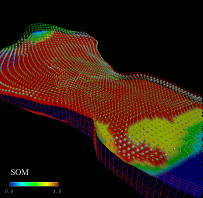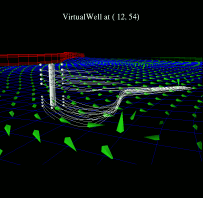
Todd Little - Western Atlas Software, Houston TX
Andy Austin, Mark Lederer - BP Exploration, Houston TX

Accurately determining the mechanisms of recovery in a hydrocarbon reservoir will directly affect the recovery efficiency of a given reservoir. In order to gain an understanding of a reservoir, the engineer uses a variety of tools to assist in the interpretation of simulation data. Of particular relevance to this project are the software tools used to visualize flux.
It is extremely difficult to visualize three-dimensional flux though porous media using a two-dimensional representation of the three-dimensional flux generated by the reservoir simulation. With current methodology, having three flux arrows representing each of the three phases (oil, gas, and water) at each grid block results in having hundreds of thousands of flux arrows in a single image for a full-field simulation model. If a highly faulted structure is incorporated, the three-dimensional flux becomes even more difficult to assimilate. Furthermore, petroleum technologists are constantly asked to review more production scenarios or alternatives in shorter periods of time, thereby increasing the need for more effective ways to interpret simulation results. The need to transform the vast amounts of simulation results into easily understood images is crucial to improving their effectiveness. An effective display of the interblock flow and flux vectors currently is not available in any commercial reservoir simulation post-processor.
Beginning with the requirements of industry as a general specification, experimental prototypes of visualization and data reduction algorithms have been implemented by LBNL. Some of the more efficacious techniques currently are being ported into a commercial environment by one of the industrial partners, and will be available as a vendor-supported product in 1996. In the space of a single year, the working reservoir engineers in industry have had the opportunity to provide direct input into the applied research of visualization of flux data and have seen these ideas brought to market.
According to Dr. Steve Webb, Director of Production Software at Western Atlas Software in Houston, TX, "The collaboration we have had with LBL recently has, in our opinion, moved flux visualization forward significantly. This has resulted, I believe from cross industry fertilization possible in these types of collaborative projects. Moreover, I believe LBL has gained valuable insight into the use of its technology in an industry it has not hitherto explored. This is what the ACTI projects should be about. Most do not make it past the talking stage. This one is unique, in our experience, because it has actually produced some tangible results."
Biparametric geometric icons are used to simultaneously represent both oil
flux and the saturation of oil.
